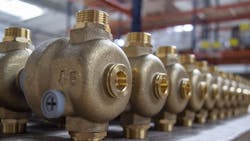Pressure Under Control: How Pressure Reducing Valves Help Prevent Leaks
Key Highlights
- PRVs help prevent plumbing failures caused by excessive or fluctuating water pressure, protecting pipes and fixtures from damage
- Installing PRVs is a cost-effective, proactive measure that reduces long-term repair costs and homeowner callbacks
- They contribute to water conservation efforts by controlling system pressure and reducing unnecessary water usage
In today’s homebuilding and plumbing environments, water conservation isn’t just a sustainability goal—it’s a business and liability imperative. From fluctuating municipal water supplies to the risk of excessive pressure damaging pipes and fixtures, residential and commercial plumbing systems face new stressors that demand smarter solutions. Pressure reducing valves (PRVs) offer a reliable first line of defense.
PRVs help homeowners and professionals solve one of the most common causes of leaks: inconsistent or excessive water pressure. When pressure spikes—especially in new construction zones where municipal pump stations evolve over time—home plumbing systems are at risk of burst pipes, fixture damage and water waste.
PRVs regulate incoming pressure, reducing the risk of catastrophic failure and improving overall system efficiency. They also help minimize energy use in homes that rely on water pressure to drive appliance performance, such as dishwashers and washing machines.
The Case for Pressure Control
When my dad went through heart failure last year, the doctors explained that part of the problem was a restriction in one of his arteries—like a kink in a vital pipe that kept blood from flowing the way it should. Once they cleared that blockage, his heart could pump more freely, easing the pressure and giving his body the steady flow it needed.
It reminded me of how a pressure reducing valve works in a plumbing system. If water comes in at too high of a pressure or gets blocked along the way, the whole system is at risk—pipes can burst, joints can leak and fixtures can fail. But when the restriction is removed and the PRV steps in to regulate flow, everything runs smoothly, safely and with balance.
In both plumbing and in life, it’s the unseen regulators and the removal of dangerous restrictions that keep everything working the way it was designed to.
The key to preventing plumbing leaks often lies in stabilizing water pressure before it ever enters the home. In fact, in many jurisdictions, any water pressure over 80 PSI requires the use of a PRV to meet ASSE1003 code.
However, even homes that start with acceptable pressure levels can experience issues years later as nearby development expands. Builders and plumbers who understand this risk are increasingly insisting that every new home be outfitted with a PRV as a preventive measure—especially in fast-growing residential areas.
Having a PRV installed is one of the smartest and most cost-effective steps a builder or plumber can take to help protect a home from long-term damage. It also helps prevent expensive repairs and homeowner callbacks, which can damage a contractor’s reputation and bottom line. It’s the same reason it is important for my dad to manage his blood pressure. It’s a proactive first line of defense that can prevent issues before they start.
A Critical Link in Water Conservation
While much attention is given to detecting leaks after they happen, PRVs help prevent them by controlling system pressure. This not only conserves water but reduces wear and tear on appliances and fixtures.
Think of it like the plumbing equivalent of blood pressure control: unchecked high pressure strains your home’s internal systems, while steady regulation leads to long-term health.
With rising awareness of water usage and the cost of water-related damage, PRVs represent a simple yet powerful step toward conservation and protection. They can also contribute to improved performance in smart water monitoring and leak detection systems, serving as the first line of defense before alerts are ever triggered.
Designed for Today’s Plumbing Professionals
PRVs aren’t just designed for protection; they’re built with performance and flexibility in mind. For example, Resideo’s PRV range includes models for residential, commercial and industrial applications. Key features across the portfolio include:
- Connection flexibility, including recent introductions of press-connect options
- Models designed specifically for use with tankless water heaters
- Integrated filters to block sediment and protect downstream fixtures
- Made-in-Germany engineering and design quality
Resideo’s legacy in plumbing projects, built under the Braukmann name, spans more than 90 years and reflects a proven track record of reliability and performance valued by contractors and wholesalers alike. Resideo offers a full range of PRVs to meet varying project needs, from reliable everyday models to premium, high-performance solutions.
For contractors looking to standardize their installation process or streamline inventory, the breadth and consistency of the Resideo PRV portfolio is a valuable asset. Whether you’re installing one unit or hundreds, the same reliability and product support apply.
With growing pressure on homes from aging infrastructure and new development, PRVs are more relevant than ever. Whether used in new construction or as part of a retrofit upgrade, Resideo PRVs provide the protection, consistency and water conservation today’s homes demand.
About the Author
Jason Abajian
Jason Abajian is the North America Sales Manager - Plumbing Channel & Key Accounts at Resideo. With more than 20+ years in the HVAC industry, he brings a unique background that combines classroom teaching with hands-on field experience. Jason is passionate about educating the next generation of professionals and advancing high-performance, environmentally responsible water solutions across residential and commercial markets.
